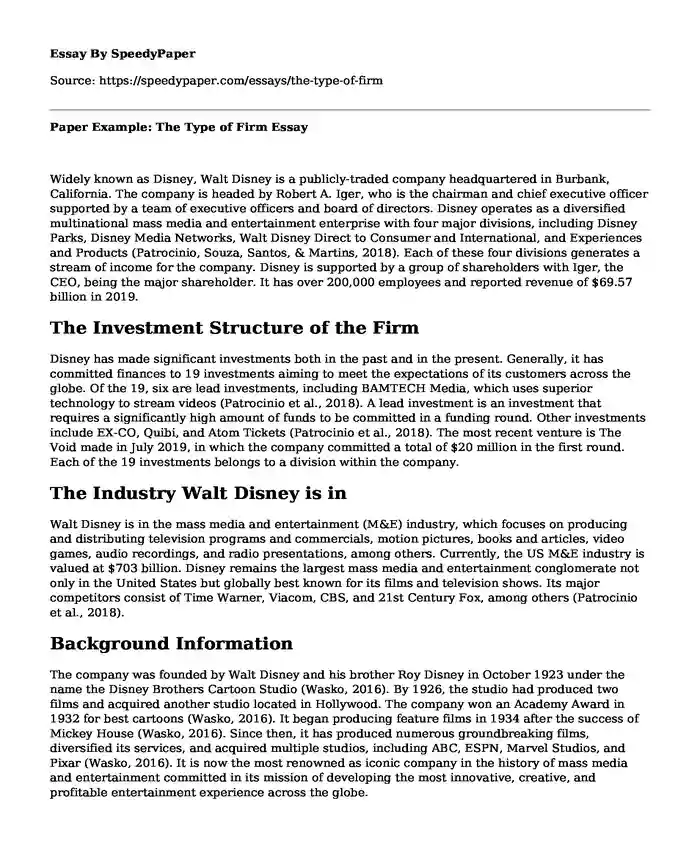
| Type of paper: | Research paper |
| Categories: | Movie Financial analysis Leadership style |
| Pages: | 3 |
| Wordcount: | 621 words |
Widely known as Disney, Walt Disney is a publicly-traded company headquartered in Burbank, California. The company is headed by Robert A. Iger, who is the chairman and chief executive officer supported by a team of executive officers and board of directors. Disney operates as a diversified multinational mass media and entertainment enterprise with four major divisions, including Disney Parks, Disney Media Networks, Walt Disney Direct to Consumer and International, and Experiences and Products (Patrocinio, Souza, Santos, & Martins, 2018). Each of these four divisions generates a stream of income for the company. Disney is supported by a group of shareholders with Iger, the CEO, being the major shareholder. It has over 200,000 employees and reported revenue of $69.57 billion in 2019.
The Investment Structure of the Firm
Disney has made significant investments both in the past and in the present. Generally, it has committed finances to 19 investments aiming to meet the expectations of its customers across the globe. Of the 19, six are lead investments, including BAMTECH Media, which uses superior technology to stream videos (Patrocinio et al., 2018). A lead investment is an investment that requires a significantly high amount of funds to be committed in a funding round. Other investments include EX-CO, Quibi, and Atom Tickets (Patrocinio et al., 2018). The most recent venture is The Void made in July 2019, in which the company committed a total of $20 million in the first round. Each of the 19 investments belongs to a division within the company.
The Industry Walt Disney is in
Walt Disney is in the mass media and entertainment (M&E) industry, which focuses on producing and distributing television programs and commercials, motion pictures, books and articles, video games, audio recordings, and radio presentations, among others. Currently, the US M&E industry is valued at $703 billion. Disney remains the largest mass media and entertainment conglomerate not only in the United States but globally best known for its films and television shows. Its major competitors consist of Time Warner, Viacom, CBS, and 21st Century Fox, among others (Patrocinio et al., 2018).
Background Information
The company was founded by Walt Disney and his brother Roy Disney in October 1923 under the name the Disney Brothers Cartoon Studio (Wasko, 2016). By 1926, the studio had produced two films and acquired another studio located in Hollywood. The company won an Academy Award in 1932 for best cartoons (Wasko, 2016). It began producing feature films in 1934 after the success of Mickey House (Wasko, 2016). Since then, it has produced numerous groundbreaking films, diversified its services, and acquired multiple studios, including ABC, ESPN, Marvel Studios, and Pixar (Wasko, 2016). It is now the most renowned as iconic company in the history of mass media and entertainment committed in its mission of developing the most innovative, creative, and profitable entertainment experience across the globe.
Capital Structure
Capital forms the primary foundation of any business by providing the finances necessary for meeting daily obligations and supporting long-term goals. Companies usually use debts and equity as capitalization tools. A capital structure in which debts are more than equity might signal to stakeholders that the company is at a leveraged risk. In 2019, the company reported an equity-to-debt ratio of 0.53%, meaning that for every dollar of equity capital, it commits $0.53 of debt capital to investments (The Wall Street Journal, 2019). Its capital structure indicates that it depends more on equity rather than debt, signaling low leverage risk.
References
Patrocinio, R. F., Souza, J. L., Santos, C. T., & Martins, K. S. (2018). The vision of the Disney World: an experience marketing study at The Walt Disney Company. Archives of Business Research, 5(9). doi:10.14738/abr.69.5067
The Wall Street Journal. (2019). Walt Disney Co. financial statements. Retrieved December 24, 2019, from https://www.wsj.com/market-data/quotes/DIS/financials
Wasko, J. (2016). The Walt Disney Company. Global Media Giants, 11-25. doi:10.4324/9781315682334-2
Cite this page
Paper Example: The Type of Firm. (2023, Mar 21). Retrieved from https://speedypaper.net/essays/the-type-of-firm
Request Removal
If you are the original author of this essay and no longer wish to have it published on the SpeedyPaper website, please click below to request its removal:
- Lewy Body Dementia Clinical Trials - Free Essay in Medicine
- Essay Example: Benefits of New Knowledge Learned from Space Exploration
- Compulsive Hoarding Disorder, Essay Example on Mental Disorder
- Political Philosophies - An Essay Sample for Everyone
- Free Essay on Hyperkalemia
- Free Essay: The Vietnam War Was Unfairly Destructive to the United States
- Essay Sample on The Leadership Blind Spots at Wells Fargo
Popular categories




